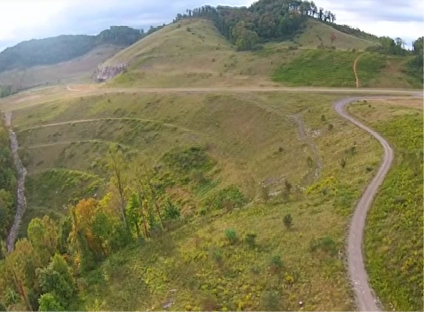Earlier this year, the Interstate Mining Compact Commission (IMCC) handed down its newest National Reclamation Award to Alpha Natural Resources’ Paramont Coal for work completed on thousands of acres at the Hawks Nest surface reclamation project in Buchanan County, Virginia.
The Hawks Nest reclamation site near Grundy, Buchanan County, Virginia, restored many aspects of the land, including stream and tree life, and has grown to include recreational, residential and commercial development.
The award, which Alpha officials received at the IMCC annual meeting in Lake Placid, New York, earlier this year, was the result of a laborious but immaculately planned yearslong project by Alpha as well as the Buchanan County Industrial Development Authority (IDA). What began as a five-acre pre-law surface operation has grown to more than 1,200 acres of reclamation, nearly all of which has been completed to date.
First production at Hawks Nest, located near Grundy, began in April 2004 and wrapped in April 2011; at its peak, the mine’s payroll was 78.
According to Maxxim Shared Services Senior Engineer Jackie Ball, the operation produced 15 million bank cubic yards (BCY) with coal totaling 600,000 tons. Hawks Nest’s equipment fleet at top operations included two Caterpillar 993K wheel loaders, Cat 785 rock trucks and four Cat D11 dozers.
“Once mining started, we continued mining until the project was completed in 2011,” he noted, adding that there was an adjacent permit previously mined by another company. “[Our] reclamation was an ongoing process during mining [and remining of the prior areas]. We tried to keep the reclamation as tight to the active operation as possible.”
Alpha first inked its contract with the IDA in 2006 to enlarge their Phase II development site by approximately 600 acres, making the full site more than 1,100 acres. Two years later and just a year after launching a feasibility study, the producer teamed up with the Virginia Department of Transportation (V-DOT) to construct the initial two miles of the state’s Coalfields Expressway, also known as the CFX, which was integrated into the Hawks Nest mining plan.

Part of Hawks Nest pre-reclamation. At its peak, the surface mine produced 15 million bank cubic yards (BCY) with coal totaling 600,000 tons.
Final reclamation wrapped in 2011, and the current Hawks Nest development has a business park, Southern Gap, with industrial and business sites as well as a growing residential area (about 600 homes at completion). Recreation areas such as the Poplar Gap community park, athletic fields, and a large playground and gymnasium are also at the site. Ball noted that, during mining on the Hawks Nest permit, Alpha was able to eliminate approximately 12 miles of pre-law highwall.
Ball noted that the company did form other partnerships along the way. Third-party contractors were of help over those years, such as Torque Enterprises, which it brought in to aid in mitigation and some of the project’s smaller details.
All told, the reclamation has included restoration of more than 4,500 feet of stream and extensive planting of hybrid American Chestnut trees. The reforestation at Hawks Nest has attracted elk, resulting in elk viewing tours beginning this year at Breaks Interstate Park.

Hawks Nest stored overburden in a terraced valley-fill during active operations.
Alpha is in the final bond release phase for the job, and expects everything to be complete sometime next year — with the exception of the portion it will keep bond on for the upcoming Route 460/CFX interchange project. That segment, which is on the western end of the permit, will ultimately tie into the Phase II 460 project already under way between V-DOT and Bizzack Construction, extending from the Breaks Interstate Park to Alpha’s Hawks Nest permit. Officials expect 460 to be entirely complete by 2018.
Ball said there were no significant challenges or obstacles to the project, and that Hawks Nest is similar to other types of reclamation efforts it has undertaken in the past. One of those was Lovers Gap 4, where Alpha again worked with the IDA to develop more than 500 acres for their industrial/residential site adjacent to Hawks Nest.
“We also enlarged the county’s park (Poplar Gap) to the size it is today,” he said. “We built more than six miles of access roads to V-DOT’s standard that connects this site to Route 83, Route 744, Route 604 and the future I-121, the Coalfields Expressway.”
One primary benefit, particularly regarding this most recent work, was the good cooperation and support the producer received from both involved regulatory agencies and the surrounding community.
He also noted there was no funding source for the mine, other than the contract with V-DOT to build the two miles of the CFX and the contract with IDA. According to V-DOT data, Alpha saved the state of Virginia approximately 90%, or $90 million, on that portion of roadway ($2 billion is the expected savings for the 26 miles of CFX on Alpha’s side).
“Whether it’s returning the land to the original contour or developing it for beneficial public use, we have had great success in providing long-term benefits to the region,” said Blake Hall, vice president of operations. “Environmental stewardship is a priority within any mine plan, and we pride ourselves on demonstrating how reclaimed land can bring opportunities to the region after the mining has been completed.”
“[We] have a love for the land, and…it shows through in the work that’s done, the product that we create,” added Alpha Vice President of Environmental Affairs John Paul Jones.
The project is clearly an important one for the region as well.
“[It represents] major growth in Buchanan County for the next 40 to 50 years, including hotels and shopping, manufacturing and business…in Southern Gap,” IDA Director Craig Horn said.





